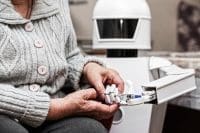By Julie Cullen, Managing Editor, American Nurse Today

I recently spoke with Elizabeth Monsees, PhD, RN, CIC, FAPIC, antimicrobial stewardship program manager at Children’s Mercy Kansas City and first author of the article “Integrating staff nurses in antibiotic stewardship: Opportunities and barriers.” She and her colleagues developed an online survey to assess 10 practices related to inpatient nurses’ care and their confidence in performing practices that support the stewardship process. She shared some of their findings with us.
In looking at the literature, it seems that nursing’s role in antibiotic stewardship has been talked about for several years. Is there resistance in healthcare organizations to include nurses in stewardship programs? Are nurses reluctant to participate? Or is it a combination of factors?
It has not been my experience that healthcare organizations are resistant to the inclusion of nurses, rather, as Rita Olans has described, the role of nurses in stewardship has been largely unrecognized. We have found in our research that nurses have a desire to participate and believe we have a professional role to be involved in stewardship, and it is consistent with a new multisite study we recently conducted and are in the process of data analysis. One of the early researchers on this topic raised a really important point addressing the multifaceted aspects of this work—when nurses perceive work climate factors, how the teams interact, and hierarchy as sensitive areas, they may defer to prescribers and be less likely to raise a question when uncertain in their own antibiotic knowledge. These factors suggest there are opportunities to help build collaborative relationships between disciplines that promote learning and shared understanding.
It’s probably a safe bet that preparing nurses to be active participants in antibiotic stewardship programs begins in nursing school. What are schools doing to ensure nurses graduate with the knowledge and confidence they need to do that?
I’m not actively involved in academic settings, but in conversation with nursing professors, the general trend is that antibiotic use is taught as it historically has been taught, teaching about medications, treatments, safe medication administration, and microbiology. An area that still needs work is how nurses participate as part of the clinical team, and there are some schools using interprofessional team teaching that would be a vehicle for this type of specialty education.
I imagine the culture of a hospital often determines the approach to antibiotic stewardship and nurses’ participation in these programs. If necessary, what’s the best way for nurses to change a hospital’s culture on this topic?
You are correct—the goal of stewardship is really to create a collective consciousness on how all providers optimize therapies. Nurses are integral to organizational change by providing input on where they envision their participation. In our hospital, different units had different priorities on where nurses were identifying issues. For example, nurses on our surgical unit revealed opportunities to decrease drug waste after procedures. Another unit identified redundant practices. This work is really about developing partnerships to complement stewardship processes. Nurse managers/directors are key in allocating resources for education about nurses’ role in stewarding. They also empower nurses to assume their role as key collaborators or team members in this antibiotic stewardship space. Specifically regarding education, it may help leaders to know that for facilities with the Joint Commission accreditation, it is part of the stewardship standard that key staff, including nurses, are provided education and regular reports on the state of bacterial resistance.
What resources can nurses turn to for education on antibiotic stewardship and to help them advocate for inclusion in stewardship programs?
A number of resources are available including the CDC’s Core Elements; the ANA-CDC white paper provides an excellent overview of where nurses can and do contribute to stewardship processes. I have recently learned that the Agency for Healthcare Research and Quality will be providing information on team-based stewardship models next year. I also would encourage nurses to speak with their facility’s infection preventionist and/or stewardship leaders to express interest. Those disciplines would welcome input and are certainly instrumental in guiding internal educational endeavors.
Please provide a few quick takeaways on antibiotic stewardship and nursing’s role.
Nurses’ day-to-day clinical work practices influence antibiotic decision-making. For example, nurses observe whether patients are tolerating oral substances or if the vascular line is sluggish. Raising those clinical observations to the prescriber may promote the transition from I.V. therapy to oral, thus minimizing line complications and potentially shortening the length of hospitalization. Another practice is clarifying the antibiotic intention and duration, and questioning if the ordered antibiotics are not specified in culture and sensitivity reports. Nurses can be powerful resources during patient/family education to discuss appropriate antibiotic use, potential side effects, and general infection prevention measures.
Our study and others have identified that nurses want to be involved in stewardship work. Nurses have shared that education is needed to help correct a perceived knowledge debt but also that workplace culture is an area that needs further exploration. We are really in an exciting space and area ripe for innovation. As the one discipline present in all settings of care, we have a unique lens to identify areas where work processes can be strengthened, team interactions can be enhanced, and where there are vital opportunities to provide value-based care to directly improve patient antibiotic use.


















